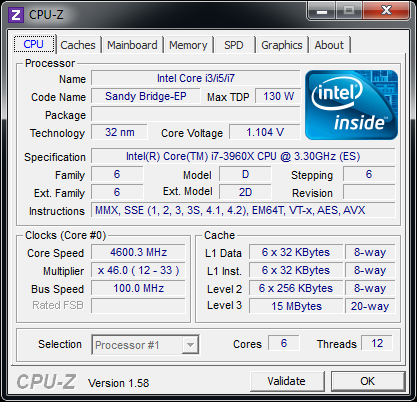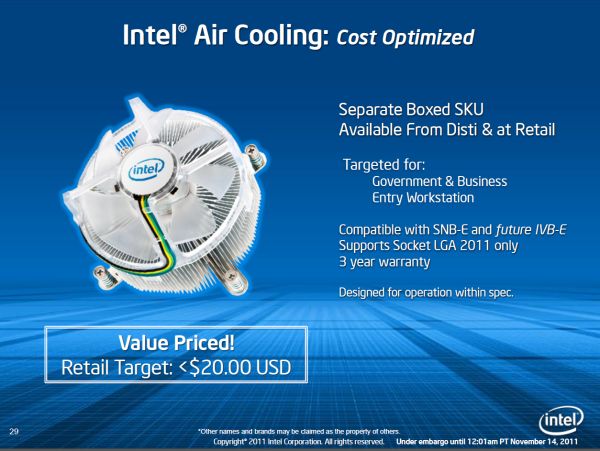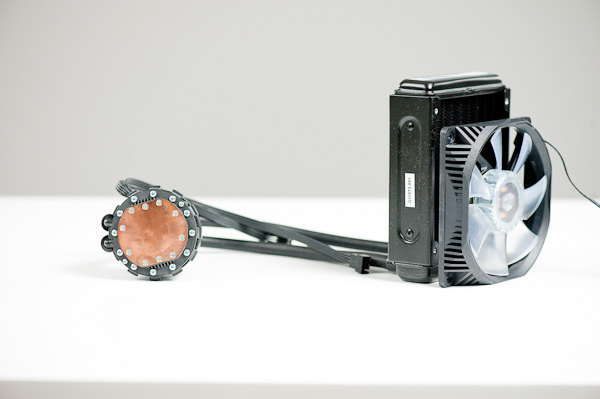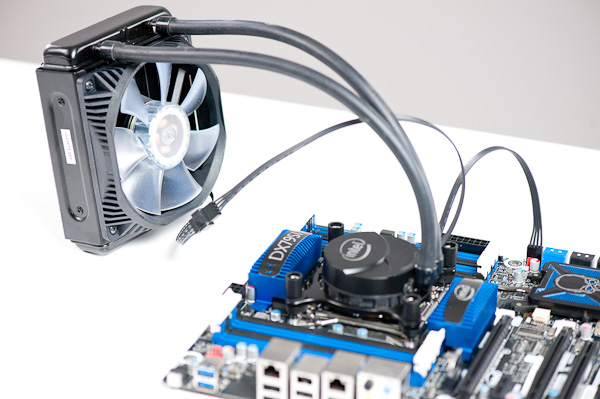Intel Core i7 3960X (Sandy Bridge E) Review: Keeping the High End Alive
by Anand Lal Shimpi on November 14, 2011 3:01 AM EST- Posted in
- CPUs
- Intel
- Core i7
- Sandy Bridge
- Sandy Bridge E
Overclocking
Sandy Bridge brought the motherboard's clock generator onto the 6-series chipset die. In doing so, Intel also locked its operation to 100MHz. While there was a bit of wiggle room, when combined with a locked processor, Intel effectively killed overclocking with most lower end Sandy Bridge chips.
For its more expensive CPUs, Intel offered either partially or fully unlocked (K-series) CPUs. The bus clock was still fixed at 100MHz, but you could overclock your processor by increasing its clock multiplier just like you could in the early days of overclocking.
With Sandy Bridge E, overclocking changes a bit. The clock generator is still mostly impervious to significant bus clock changes, however you're now able to send a multiple of its frequency to the CPU if you so desire. The options available are 100MHz, 125MHz, 166MHz and 250MHz.
Once again, wiggle room at any of these frequencies is limited so don't think we've moved back to the days of bus overclocking. You do get a little more flexibility, particularly with partially unlocked CPUs, but otherwise SNB-E overclocking is hardly any different from its predecessor.
Note that even if you select any of these options, the rest of the system still operates within spec. The multiplied bus clock is only fed to the CPU.

With a bit of effort I had no problems hitting 4.6GHz on my Core i7 3960X review sample. I had to increase core voltage from 1.104V to 1.44V, but the system was stable. While I could get into Windows at 4.8GHz and run a few benchmarks, the system wasn't completely stable.
No Cooler Included
None of the retail or OEM SNB-E parts include an Intel cooler in the bundle, a significant departure from previous CPUs. Presumably the cost of bundling a beefy cooler with these parts would've driven prices higher than Intel would've liked (remember you are getting a much larger die for roughly the same price as the outgoing Core i7 990X). Intel can also rationalize its decision against including any sort of cooler in the retail box by looking at the fact that many enthusiasts at this level opt for aftermarket cooling regardless.
Intel hasn't completely left SNB-E cooling up to 3rd party vendors however. There are two official Intel coolers available for use with SNB-E. The first is a < $20 heatsink that looks a lot like Intel's current coolers but with a couple of modifications (clear fan/shroud, retention screws instead of pegs). Intel states that this cooler is designed for operation within spec, meaning it could possibly limit overclocking attempts.

If you want an Intel branded overclocking solution, there's the RTS2011LC:

This is a closed loop liquid cooling solution similar to what AMD introduced alongside its Bulldozer CPU and similar to what many 3rd party cooling companies already offer. Intel expects its liquid cooling solution to be priced somewhere in the $85 - $100 range.
These closed loop liquid coolers are great primarily for getting away from the tower-of-metal heatsinks that have grown in popularity over the past several years. The radiator is a too small to compete with more traditional water cooling systems, but it can be a good gateway drug for the risk averse.











163 Comments
View All Comments
Hauk - Monday, November 14, 2011 - link
Was hoping to get 40 PCI-E lanes & 2600K performance for $300.. craptastic that they delay the 3820 till next year. Can't wait any longer, 2600K it is..medi01 - Monday, November 14, 2011 - link
Hi,why don't we see AMD cpu pricing along Intel CPU pricing?
g00ey - Monday, November 14, 2011 - link
I think it is false advertising to call the Bulldozer 8C an eight core CPU. It doesn't really have eight cores, it's actually only four cores where they have added an extra ALU inside each core. It's like doubling the core count of the i7s because of the hyperthreading (SMT) feature. The addition of ALUs is nothing but an enhanced version of hyperthreading so a Bulldozer 8C is only 4 cores, 6C is only 3 cores and 4C is only 2 cores.But AMD say; No No No, there are two computation CORES inside each MODULE.
What a BIG WAD of *BULLSHIT*!!!!!!!!!!!!!!!!!!!!!!!!!!!!
They should be thrown into jail for such fraudulent statements!!!
raddude9 - Monday, November 14, 2011 - link
Nope Mr. Troll.Bulldozer 8C can run 8 threads simultaneously. Sandy Bridge E with it's 6 multi-threaded cores can only run 6 threads at the same time, the other 6 threads have to wait.
BSMonitor - Monday, November 14, 2011 - link
Actually you are completely wrong.Hyperthreading actually allows 12 threads to fully utilize the resources of a 6 core processor.
Whereby, Bulldozer simply has double the Integer hardware. Allowing it to run 8 integer threads simulateously. So long as there are that many consecutive integer computations in a row on each thread. Beware when floating point threads start to appear. And then it crawls back to 4 cores.
raddude9 - Monday, November 14, 2011 - link
What did I say that is wrong?Hyperthreading means that each core holds the state of 2 threads. Only one thread can run at a time, usually when one thread stalls, the other thread can kick in. So, at best it can run 6 threads at once, the 6 hyperthreaded threads are waiting in the backround for their chance. But it still just runs 6 threads at once.
You are trying to mislead people with your mis-information on the Bulldozer Floating Point unit. It's FPU can run as either two independent 128bit FPUs or a single 256bit FPU. So it can run two independent Floating Point instructions at once. So, Regardless of whether Bulldozer is running Floating Point or Integer instructions, it can still run 8 threads at once.
LittleMic - Tuesday, November 15, 2011 - link
You are wrong because you are describing T1000 and T2000 CPU and not Intel with HT. Sun processor are indeed hiding memory access latency this way.Intel processors are actually scheduling micro instruction from both threads according to execution resources availabitity. It is quite old technology now so the white papers have disappeared from Intel web site, but if you have a look at
http://en.wikipedia.org/wiki/Hyper-threading
the picture on the right clearly shows that a pipeline stage can contain µ instructions coming from 2 threads
LittleMic - Tuesday, November 15, 2011 - link
No edit...Finally found "official" paper directly from Intel :
http://download.intel.com/technology/itj/2002/volu...
Have a look at page 10 that shows that all the pipeline contains instructions from both threads simultanously.
Lord 666 - Monday, November 14, 2011 - link
Anand,Have read mixed information on the release date for the 26xx series Xeons with respect to release date and architecture. Actually holding off a much needed server because have read either December or Jan.
With the socket the same, is the reviewed SB-E the same design as the new Xeons? Will there be 3D design like Ivy Bridge?
Thanks - Loyal reader for over 7 years
mwarner1 - Monday, November 14, 2011 - link
I am impressed by how much memory you had in your 386SX! My first (IBM compatible) PC was a 486DX2-50 I bought for my Software Engineering degree and it only had 4MB. This was pretty much standard for the time.